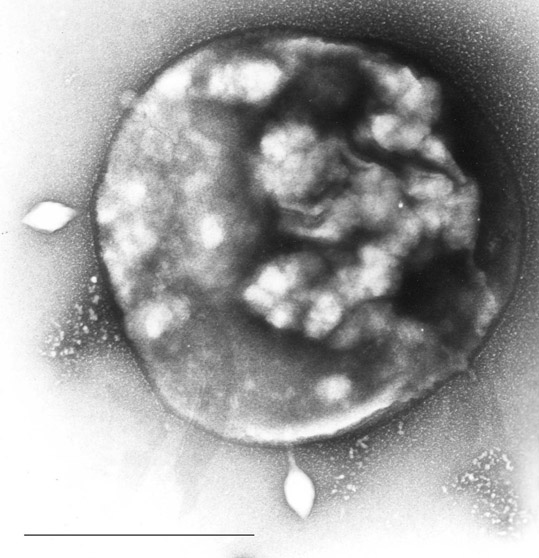- Sulfolobus
Taxobox
color = darkgray
name = "Sulfolobus"

image_width = 240px
image_caption = Electron micrograph of "Sulfolobus" infected with "Sulfolobus" virus STSV1. Bar = 1 μm.
domain =Archaea
phylum =Crenarchaeota
classis =Thermoprotei
ordo =Sulfolobales
familia =Sulfolobaceae
genus = "Sulfolobus"
genus_authority = Brock "et al." 1972
subdivision_ranks = Species
subdivision =
* "S. acidocaldarius"
* "S. islandicus"
* "S. metallicus"
* "S. neozealandicus"
* "S. shibatae"
* "S. solfataricus"
* "S. sp. AMP12/99"
* "S. sp. CH7/99"
* "S. sp. FF5/00"
* "S. sp. G81"
* "S. sp. H"
* "S. sp. JP2"
* "S. sp. JP3"
* "S. sp. K00 8-41"
* "S. sp. L00 11"
* "S. sp. L00 24"
* "S. sp. M02"
* "S. sp. MV2/99"
* "S. sp. MVSoil3/SC2"
* "S. sp. MVSoil6/SC1"
* "S. sp. NGB23/00"
* "S. sp. NGB6/00"
* "S. sp. NL8/00"
* "S. sp. NO82"
* "S. sp. NOB8H2"
* "S. sp. RC3"
* "S. sp. RC6/00"
* "S. sp. RCSC1/01"
* "S. sp. Sko-3"
* "S. sp."
* "S. sp. Ta"
* "S. sp. Tu A"
* "S. sp. Tu B-1"
* "S. sp. Y00 58-82"
* "S. sp. Y01 90#-18"
* "S. sp. Y99 9-16"
* "S. sp. Y99 9-23"
* "S. tengchongensis"
* "S. thuringiensis"
* "S. tokodaii"
* "S. yangmingensis"
* "uncultured Sulfolobus sp. "
synonyms =
* "Sulfolobus Brock et al. 1972"In taxonomy, "Sulfolobus" is a
genus of theSulfolobaceae . [See the NCBI [http://www.ncbi.nlm.nih.gov/Taxonomy/Browser/wwwtax.cgi?mode=Info&id=2284 webpage on Sulfolobus] . Data extracted from the cite web | url=ftp://ftp.ncbi.nih.gov/pub/taxonomy/ | title=NCBI taxonomy resources | publisher=National Center for Biotechnology Information | accessdate=2007-03-19]"Sulfolobus" species grow in volcanic springs with optimal growth occurring at
pH 2-3 andtemperature s of 75-80 °C, making themacidophile s andthermophiles respectively. "Sulfolobus" cells are irregularly shaped andflagella r."Sulfolobus" species are generally named after the location from which they were first isolated, e.g. "
Sulfolobus solfataricus " was first isolated in theSolfatara (volcano) . Other species can be found throughout the world in areas of volcanic or geothermal activity, such as geological formations calledmud pot s, which are also known as "solfatara" (plural of solfatare)."Sulfolobus" as a model to study the molecular mechanisms of DNA replication
As the first Archaeal genome, "Methanococcus jannaschii" , has been sequenced completely, in 1996, it was found that the genes in the genome of "Methanococcus jannaschii" involved in DNA replication, transcription, translation, were more related to those counterparts in Eukaryote than in Bacteria. In 2001, the first genome sequence of "Sulfolobus" , "Sulfolobus solfataricus" P2, was published. In P2's genome, the genes related to chromosome replication were found to be more related to Eukaryote's. These genes include DNA polymerase, primase (including two subunits), MCM, CDC6/ORC1, RPA, RPC,
PCNA . In 2004, the origins of DNA replication of "Sulfolobus solfataricus" and "Sulfolobus acidocaldarius" were identified. It showed that both species contained 3 origins in their genome. This is the first time that more than a single origin of DNA replication has been shown to be used in a prokaryotic cell. The mechanism of DNA replication in archaea is evolutionary conserved, and similar to that of Eukaryotes. "Sulfolobus" is now used as a model to study the molecular mechanisms of DNA replication in Archaea. And because the system of DNA replication in Archaea is much simpler than that in Eukarote, it was suggested that Archaea could be used as model to study the much more complexed DNA replication in Eukaryote.Role in biotechnology
"Sulfolobus" proteins are of interest for biotechnology and industrial use due to their
thermostable nature. Intracellular proteins are not necessarily stable at low pH however, as "Sulfolobus" species maintain a significant pH gradient across the outer membrane. "Sulfolobales" are metabolically dependent on sulfur:heterotroph ic orautotroph ic, their energy comes from theoxidation ofsulfur and/orcellular respiration in which sulfur acts as the final electron acceptor. For example, "S. tokodaii" is known tooxidize hydrogen sulfide tosulfate intracellularly."Sulfolobus" as a viral host
Lysogenic viruses infect "Sulfolobus" for protection. The viruses cannot survive in the extremely acidic and hot conditions that "Sulfolobus" lives in, and so the viruses use "Sulfolobus" as protection against the harsh elements. This relationship allows the virus to replicate inside the archaea without being destroyed by the environment.Genome status
The complete
genome s have been sequenced for "S. acidocaldarius" DSM 639 (2,225,959nucleotides ), "S. solfataricus" P2 (2,992,245 nucleotides), and "S. tokodaii" str. 7 (2,694,756 nucleotides).References
*
Further reading
cientific journals
*
*
cientific books
*
cientific databases
External links
* [http://img.jgi.doe.gov/cgi-bin/pub/main.cgi?section=TaxonList&page=lineageMicrobes&genus=Sulfolobus Comparative Analysis of Sulfolobus Genomes] (at DOE's IMG system)
* [http://www.genomesonline.org/search.cgi?colcol=all&goldstamp=ALL&gen_type=ALL&org_name1=genus&gensp=Sulfolobus&org_domain=ALL&org_status=ALL&size2=ALL&org_size=Kb&gen_gc=ALL&phylogeny2=ALL&gen_institution=ALL&gen_funding=ALL&gen_data=ALL&cont=ALL&gen_country=ALL&gen_pheno=ALL&gen_eco=ALL&gen_disease=ALL&gen_relevance=ALL&gen_avail=ALL&selection=submit+search Sulfolobus Genome Projects] (from [http://www.genomesonline.org Genomes OnLine Database] )
Wikimedia Foundation. 2010.
